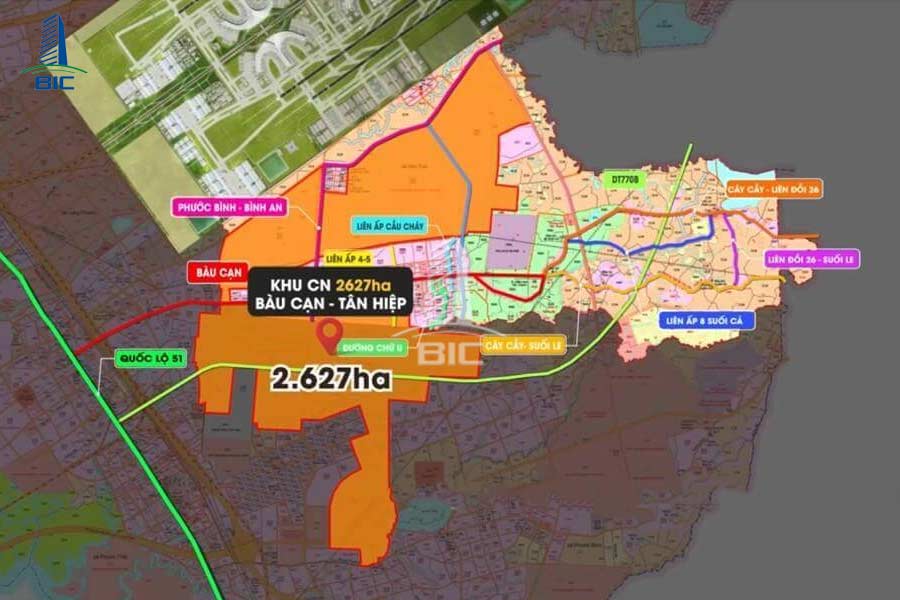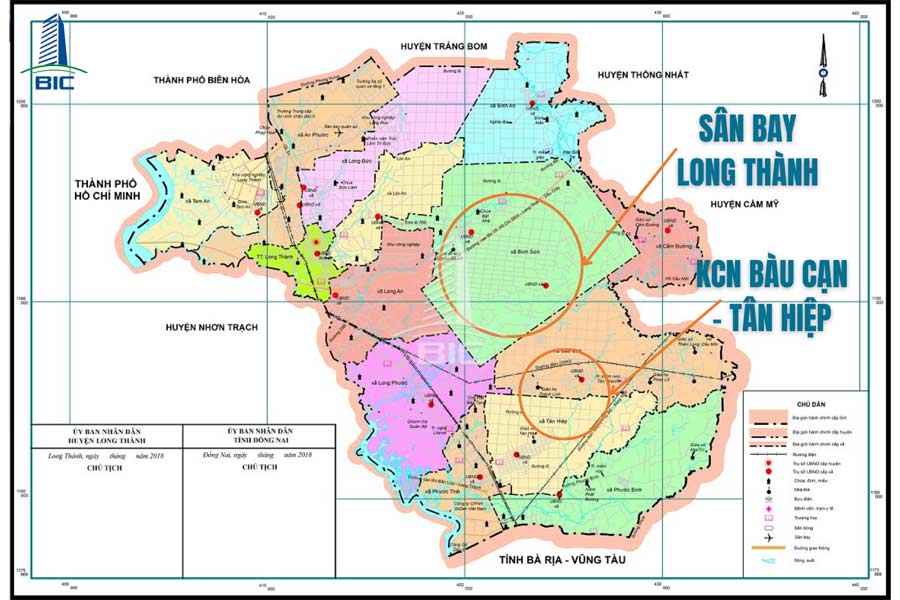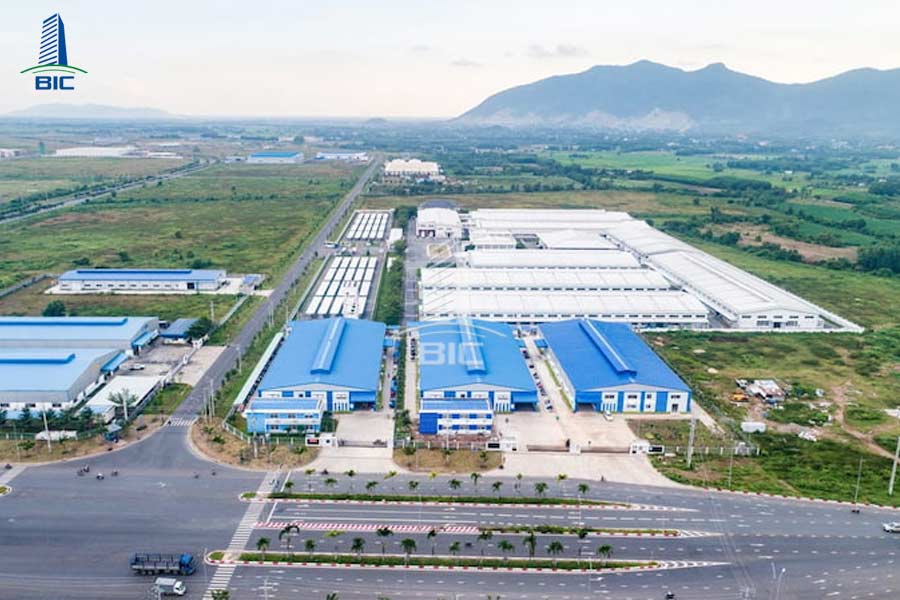
Amid the strong wave of global supply chain shifts, Vietnam especially the southern region is emerging as a strategic destination for investors in manufacturing and logistics. Thanks to its superior infrastructure and position within the Southern Key Economic Zone, Dong Nai is continuously expanding large-scale, modern industrial parks.
Bau Can Industrial Park, located near Long Thanh International Airport, stands out as a future strategic "transshipment hub." Developed under the model of a green, smart, and integrated industrial park, this location is not only ideal for manufacturing but also a golden opportunity to invest in factory design construction from the early stages.
So what makes this IP a top choice? What advantages await early investors? Let’s explore with BIC below.
Bau Can Industrial Park is situated in Bau Can and Tan Hiep communes, Long Thanh District, Dong Nai Province an area planned to become a modern airport city in the near future. Located just about 10 km from Long Thanh International Airport, the project enjoys direct access to major transport routes:
- Long Thanh – Dau Giay Expressway connecting to Ho Chi Minh City
- Provincial Road 770B (currently under expansion), forming an intra-provincial link
- National Highway 51 to Ba Ria, Vung Tau, and major seaports
This location enables businesses to access both domestic and international markets easily especially in the sectors of import-export, warehousing, and export-oriented manufacturing.
- Total planned area: approx. 2,627 ha, one of the largest industrial parks in Dong Nai.
- Phase 1: 1,000 ha approved by the Deputy Prime Minister in September 2024, with Tan Hiep Industrial Park JSC assigned as the infrastructure developer.
- Operation term: 50 years from licensing date.
- Expected groundbreaking: End of 2025, in sync with Long Thanh Airport construction progress.
Dong Nai Province is actively supporting investors with site clearance, infrastructure development, and legal procedures, making it easier for businesses to build their factories within the first years of the project.

Its close proximity to Long Thanh International Airport positions the park as a strategic "logistics hub" for warehousing and export manufacturing.
With seamless access to both air and sea ports (e.g., Cai Mep – Thi Vai), companies can reduce lead times, optimize transportation costs, and enhance global competitiveness.
Amid political uncertainties, many multinational corporations are shifting operations to Southeast Asia. With its solid infrastructure, clear legal status, and strategic location, Bau Can IP is ideal for:
- FDI businesses expanding production
- Local enterprises entering global supply chains
- Supporting industries, high-tech sectors, and new materials
Dong Nai has identified Bau Can IP as a key development project linked to Long Thanh Airport planning. Highlights include:
- Provincial Road 770B is being upgraded to connect directly to the park.
- Utilities (power, water, drainage, telecom) will be developed synchronously from the beginning.
- Local authorities are committed to supporting legal procedures, construction permits, and environmental assessments.
This support helps investors shorten project implementation time and mitigate risks.
As the IP is still in its early development stage, land lease prices and factory construction costs remain relatively low.
Early investors can benefit from:
- Priority in choosing prime locations for optimal site layout
- Lower construction costs without infrastructure congestion
- Increased asset value over time as infrastructure is completed and land prices rise.

Bau Can IP is not just a manufacturing zone but a model eco-industrial park, masterplanned by a reputable and long-established Japanese consulting group (at 1:2000 scale).
Key highlights:
- Integration of production, services, and urban functions with space optimization
- Clear zoning: factories, logistics, supporting services, social infrastructure, green areas
- Application of international sustainable and smart city development principles
Designed according to UNIDO's 2017 guidelines for eco-industrial parks, key features include:
- Wastewater reuse and energy circularity within the park
- Use of renewable energy, especially rooftop solar
- Smart waste and emission management systems to meet ESG and international environmental standards
This is crucial for exporters targeting strict markets like the EU, US, and Japan.
The park not only supports production but also enhances worker and expert living standards through:
- Worker housing, expert accommodations, schools, hospitals, sports centers
- Commercial and lifestyle services
- Green spaces, parks, and well-planned internal roads
These features create a livable, modern industrial park that attracts high-quality labor and helps businesses stabilize their workforce long-term.

The park aims to attract secondary investors in high-tech and intellectual industries to develop a modern, high-quality industrial model. This strategy, endorsed by Dong Nai’s leadership, enhances added value and competitiveness.
Its proximity to Long Thanh Airport makes it ideal for logistics, warehousing, and distribution centers industries well-suited to the integrated, modern industrial-transportation model of the park.
Infrastructure developers are required to attract secondary projects aligned with industry clusters per Decree 35/2022/ND-CP and Decree 80/2021/ND-CP. Hence, supporting industries, component manufacturing, and value chain services are encouraged.
With a focus on international eco-industrial standards and a Net Zero commitment, the park promotes clean manufacturing, energy-efficient technologies, and resource recycling. Investment is prioritized for enterprises meeting environmental and sustainable development criteria.
When an industrial park is just being launched, it presents a golden opportunity for pioneering businesses to build a solid foundation for sustainable and efficient investment. Bau Can – Tan Hiep IP offers clear advantages in infrastructure, legal status, and flexible planning.
At early stages, land and infrastructure costs are highly competitive significantly lower than in fully developed or peak-operation IPs.
Early movers can select prime plots near key internal roads, making transport more convenient and allowing for optimal masterplanning of facilities.
This phase allows enterprises to fully customize factory designs based on their production models, technologies, and operational requirements.
From warehouse layout, production zones, admin offices to truck access points everything can be planned efficiently from the start, reducing renovation costs and boosting operational efficiency later.
Another key benefit of early investment is faster processing of documents, as the infrastructure is not yet congested and administrative procedures are still streamlined.
Additionally, both the local government and the infrastructure developer are committed to supporting investors with construction permits, design appraisals, and environmental impact assessments ensuring smooth and timely factory development.
Bau Can Industrial Park gathers all the essential elements to become a strategic hub for manufacturing, logistics, and high-tech enterprises. Investing early not only optimizes costs but also opens up asset value appreciation, operational advantages, and a strong position in the global supply chain shift. Contact BIC for expert support in factory design and legal consultation for your industrial development project.